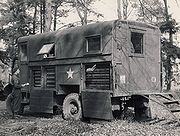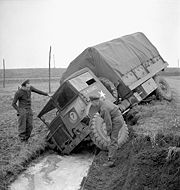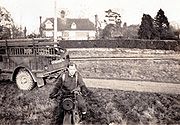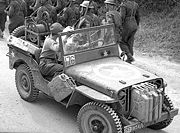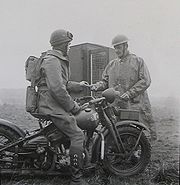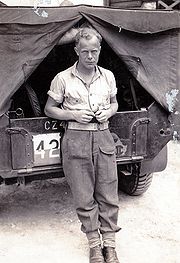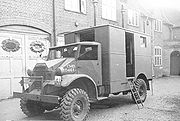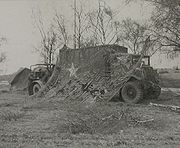Vehicle Markings - Second World War - Canadian Army Overseas
|
There has been discussion and uncertainty in various circles about the marking borne by Royal Canadian Corps of Signals vehicles during the Second World War. While this page is being developed, it may be inaccurate or in flux while new information is gathered. If you can contribute to this topic, please do by sending an email to rcsigs@rcsigs.ca!
From early in the war, the British regulated a system of vehicle markings that they had created before the war and continued to evolve and administer after the war began in 1939. As the British and Canadian armies grew to meet the demand for new and different types of formations, the need for unique systems of identification also arose. An early instruction[2] outlined the need for Divisional Signs, Unit Signs and Bridge Classification Signs to ensure efficient traffic control however by war's end, vehicle markings grew to include Formation signs, Unit signs, Tactical signs, Bridge classification signs, War Department/Census numbers and Identification signs.
Contents
Formation Signs
Formation signs indicated which formation a vehicle belonged to. The measured 6-1/2 inches high by 9 inches wide and were painted on the left front and right rear fenders of vehicles, or the corresponding position if the vehicle did not have fenders. In the case of motorcycles, direction was given that formation signs were not to be used however this was not universally followed.
Unit Signs
The purpose of unit signs was to ensure efficient traffic control and assist in recognition. Unit Signs consisted of two elements, andEarly in the war, a standard sequence of serial numbers was assigned for each unit in corps and divisions, to be assigned as needed. The system quickly grew beyond control as a plethora of units were created, new arm of service colours had to be adopted (for Britain's new Reconnaissance Corps and the Royal (Canadian) Electrical and Mechanical Engineers). As well, markings for units outside of division and corps organization had to be established (i.e. independent tank brigades, Army-level units, Line of Communications troops, etc.)
Initial direction[2] directed a black background for RCCS units. At Corps level, serial 31 and 32 (as a spare) were allocated while at division level, 11 was allocated. It was noted that for Signal Sections attached to Infantry Brigades, Artillery or other units, the serial number and the colour of the formation or unit to which they were attached would be adopted.
After the losses in France and Belgium, it was decided to alter the serial numbers of Corps Troops and Divisions.[3] The Corps Signals assignment became 41 and 42 (spare) while the Divisional Signals was assigned 52.
Further changes were made early in 1941. In a letter dated 24 January 1941,[4] C.M.H.Q. issued direction that for Signals Vehicles that "the distinguishing colour for all signals vehicles will be a BLUE and WHITE (horizontal) background, whatever the unit or formation to which they are attached. They will, however, continue to bear the serial number of the unit or formation to which they are attached painted in RED on the the BLUE and WHITE background."
As the war progressed, the assigned serial numbers used for unit signs continually evolved to keep pace with new units and unit types. This can lead to some confusion as numbers could mean different things at different times.
Sections were attached from Divisional Signals and Independent Armoured Brigade Signals to individual brigades, armoured regiments and to Divisional/Brigade troops such as artillery and engineers so a wide range of serial numbers could be found on the the white and blue background. To see a list of serial numbers in use, please see the excellent pages at Canadiansoldiers.com for Infantry Divisions, Armoured Divisions and Independent Armoured Brigades.
First Canadian Army Signals used the serial number 9 but other composite units/sections used their own serial number. While perhaps not complete, please see First Canadian Army Unit Signs for reference.

|

| |||||
| First Canadian Army Signals | Divisional Signals | 1st Armoured Brigade Signals | 2nd Armoured Brigade Signals |
To research: Early regulations stated that in the case of Corps units, a white horizontal 2 inch bar would be painted above the unit sign. ???There are Signals vehicles with red bars - is that because a white bar on top of the white upper area would not stand out?
Army Signals unit signs appear to have a red bar underneath - authority reference?
Tactical Signs
Tactical signs denoted the role of a vehicle within its own unit. The special geometric-shaped tactical signs of the armoured regiments are most commonly known as are the red and blue tactical markings of artillery regiments, but in matter of fact all units, be they echelon, base, or even infantry battalions, utilized them to help designate special roles, functions or equipment performed/carried by certain vehicles.
In general the signs measured 8 by 6 inches, painted in black with a 5/8-inch yellow border, and having yellow characters 5-8" in thickness not to exceed 2-1/2" wide and 3-1/2" high. These signs were generally applied to the right front bumper (or fender) and located on the rear centre of the vehicle's body, though sometimes it was located instead on the right rear near the formation sign. The signs were also placed on vehicle sides, either centrally on the leading door, on the turret of armoured vehicles, or on the body of Universal Carriers. The numbers were standardized by individual corps and services, and for infantry units and formation headquarters, by First Canadian Army.
An early example of the Tactical Sign allocation within a Canadian Infantry Divisional Siganals can be found here: Tactical Vehicle markings - a Divisional Signals - August 1941.
Bridge Classification Signs
In 1940 the War Office adopted a system of classification and marking of both bridges and of vehicles in order to mitigate the risk of damage to bridges from use by vehicles producing a greater load than that for which a bridge has been designed.[5]
The classes were designated in multiples of one ton, with the minimum being 1 although the vehicle weight classifications did not necessarily denote the actual weight in tons of the vehicle although with armoured vehicles that was often the case. The classifications were instead derived from considerations such as axle loading, distance between axles, and impact factor. Bridges were to be marked with signs indicating the class, as was the route on which vehicular traffic would take to the bridge. Vehicles pulling trailers would have two classifications, one indicating the weight class of the vehicle only, the other the weight class of both vehicle and trailer. Trailers were given double classifications as well; one number designated the increase to be made to the class of the towing vehicle, while the lower number was the weight class of the trailer on its own.
In order to help bridge sentries determine the weight of vehicles wanting to cross them, bridging discs were added to Canadian vehicles. These discs were 6 inches in diameter, painted yellow, bearing black numbers which indicated the weight class of the vehicles. The discs could either be a metal plate attached to the vehicle or else painted directly onto the vehicle. They were usually located on the right front fender, though on many vehicles the disc replaced the right front headlight.
Vehicle classifications were rated so that they could cross a bridge with the same, or greater, numerical designation. For example, a Class 12 vehicle could safely cross a Class 12 bridge or a Class 18 bridge, but not a Class 5 bridge.
War Department/Census Numbers
The Canadian Army in the UK initially came under the command of British formations and transport was originally drawn from British sources. British census numbers were adopted (known correctly as War Department (WD) Numbers). These numbers were unique identifiers, used in conjunction with a letter prefix identifying the type of vehicle. Early on, the use of a "C" prefix to identify Canadian vehicles was also adopted.
These numbers were to be 3-1/2 inches high, and were painted in white, either horizontally, or if there was no room, diagonally, on the hood of cars and trucks, or on the body of tanks and armoured vehicles. Motorcycles and some trucks had the WD number on the sides of gas tanks. WD numbers also appeared on the back of vehicles; for trucks they were located centrally, 4 inches above the tailgate, and on jeeps they were painted on the left side.
- CA - Ambulance
- CC - Motorcycle
- CF - Armoured Car or Scout Car
- CH - Tractors (ie Artillery tractors)
- CL - Lorry (30 cwt or heavier)
- CM - Car (staff car, jeep, etc.)
- CS - Self-Propelled Gun
- CT - Universal Carrier or Tank
- CX - Trailers of all types
- CZ - Truck (15 cwt and smaller)
Until Census Numbers had been allocated by the RCOC, all vehicles on assembly in the UK to Canadian contract acquired "CMD" prefixes with numbers in batches allocated to each assembly point. "CMD" stood for Canadian Mechanization Depot and this number acted as a "trade plate" to move vehicles around without Census Numbers.
National Identification
Recognition markings were used to identify vehicles to friendly forces, especially aircraft. Canadian armoured vehicles in the United Kingdom used a red/white/red recognition flash which was a holdover from the First World War. The 14th Canadian Tank Regiment (The Calgary Regiment) used this style of recognition mark on its vehicles at Dieppe, and Canadian AFVs in the Mediterranean also commonly employed this style of AFV recognition marking.In 1942, rondels were to be painted on all other vehicles, of the same type used by Royal Air Force and Royal Canadian Air Force aircraft, usually located on the hood.
By June 1944, all Allied vehicles going into Northwest Europe were to have the five pointed American star painted on them instead. These stars sometimes had a circle, either broken or unbroken, painted around them as well. Canadian units often painted the star on crooked in order to differentiate themselves from American units.
Examples and Instructions
Period orders and publications provide evidence and examples of the various vehicle markings, both what they were and how they were to be applied. Please see:
- Tactical Vehicle markings - a Divisional Signals - August 1941
- Vehicle Marking Instructions - First Cdn Army Signals - Oct 1942
- Painting and Marking of Vehicles - 1 Division Signals Instruction - March 1944

